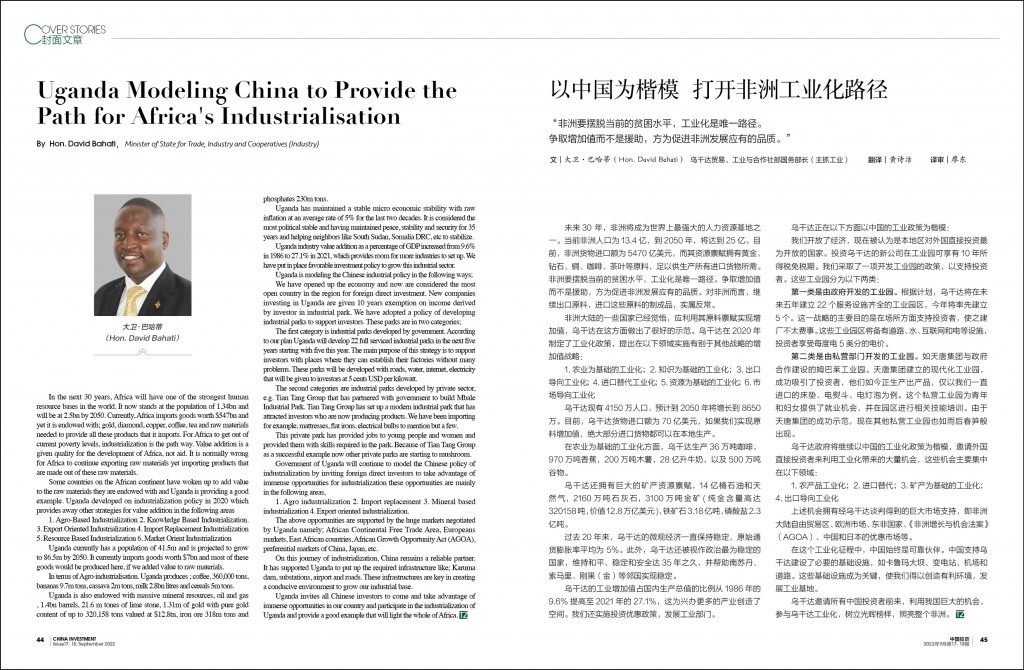
9月封面文章
为何要 “扎根非洲”
● 非以中国为楷模 打开非洲工业化路径 / 大卫·巴哈蒂(Hon. David Bahati)
● 在乌干达的实干兴邦实践——专访天唐集团副董事长、总经理王文通 / 李雅温
● 探索中非产业发展对接之路——天唐集团的非洲投资实践与思考 / 唐溪源
By Hon. David Bahati, Minister of State for Trade, Industry and Cooperatives (Industry)
文|大卫·巴哈蒂(Hon. David Bahati) 乌干达贸易、工业与合作社部国务部长(主抓工业) 翻译|黄诗洁 译审|廖东
导读
In the next 30 years, Africa will have one of the strongest human resource bases in the world. It now stands at the population of 1.34bn and will be at 2.5bn by 2050. Currently, Africa imports goods worth $547bn and yet it is endowed with; gold, diamond, copper, coffee, tea and raw materials needed to provide all these products that it imports. For Africa to get out of current poverty levels, industrialization is the path way. Value addition is a given quality for the development of Africa, not aid. It is normally wrong for Africa to continue exporting raw materials yet importing products that are made out of these raw materials.
Some countries on the African continent have woken up to add value to the raw materials they are endowed with and Uganda is providing a good example. Uganda developed on industrialization policy in 2020 which provides away other strategies for value addition in the following areas
1. Agro-Based Industrialization 2. Knowledge Based Industrialization. 3. Export Oriented Industrialization 4. Import Replacement Industrialization 5. Resource Based Industrialization 6. Market Orient Industrialization
Uganda currently has a population of 41.5m and is projected to grow to 86.5m by 2050. It currently imports goods worth $7bn and most of these goods would be produced here, if we added value to raw materials.
In terms of Agro-industrialisation. Uganda produces ; coffee, 360,000 tons, bananas 9.7m tons, cassava 2m tons, milk 2.8bn litres and cereals 5m tons.
Uganda is also endowed with massive mineral resources, oil and gas , 1.4bn barrels, 21.6 m tones of lime stone, 1.31m of gold with pure gold content of up to 320,158 tons valued at $12.8tn, iron ore 318m tons and phosphates 230m tons.
Uganda has maintained a stable micro economic stability with raw inflation at an average rate of 5% for the last two decades. It is considered the most political stable and having maintained peace, stability and security for 35 years and helping neighbors like South Sudan, Somalia DRC, etc to stabilize.
Uganda industry value addition as a percentage of GDP increased from 9.6% in 1986 to 27.1% in 2021, which provides room for more industries to set up. We have put in place favorable investment policy to grow this industrial sector.
Uganda is modeling the Chinese industrial policy in the following ways;
We have opened up the economy and now are considered the most open country in the region for foreign direct investment. New companies investing in Uganda are given 10 years exemption on income derived by investor in industrial park. We have adopted a policy of developing industrial parks to support investors. These parks are in two categories;
The first category is industrial parks developed by government. According to our plan Uganda will develop 22 full serviced industrial parks in the next five years starting with five this year. The main purpose of this strategy is to support investors with places where they can establish their factories without many problems. These parks will be developed with roads, water, internet, electricity that will be given to investors at 5 cents USD per kilowatt.
The second categories are industrial parks developed by private sector, e.g. Tian Tang Group that has partnered with government to build Mbale Industrial Park. Tian Tang Group has set up a modern industrial park that has attracted investors who are now producing products. We have been importing for example, mattresses, flat irons, electrical bulbs to mention but a few.
This private park has provided jobs to young people and women and provided them with skills required in the park. Because of Tian Tang Group as a successful example now other private parks are starting to mushroom.
Government of Uganda will continue to model the Chinese policy of industrialization by inviting foreign direct investors to take advantage of immense opportunities for industrialization these opportunities are mainly in the following areas,
1. Agro industrialization 2. Import replacement 3. Mineral based industrialization 4. Export oriented industrialization.
The above opportunities are supported by the huge markets negotiated by Uganda namely; African Continental Free Trade Area, Europeans markets, East African countries, African Growth Opportunity Act (AGOA), preferential markets of China, Japan, etc.
On this journey of industrialization, China remains a reliable partner. It has supported Uganda to put up the required infrastructure like; Karuma dam, substations, airport and roads. These infrastructures are key in creating a conducive environment to grow our industrial base.
Uganda invites all Chinese investors to come and take advantage of immerse opportunities in our country and participate in the industrialization of Uganda and provide a good example that will light the whole of Africa.
未来30 年,非洲将成为世界上最强大的人力资源基地之一。当前非洲人口为13.4亿,到2050年,将达到25亿。目前,非洲货物进口额为5470亿美元,而其资源禀赋拥有黄金、钻石、铜、咖啡、茶叶等原料,足以供生产所有进口货物所需。非洲要摆脱当前的贫困水平,工业化是唯一路径。争取增加值而不是援助,方为促进非洲发展应有的品质。对非洲而言,继续出口原料,进口这些原料的制成品,实属反常。
非洲大陆的一些国家已经觉悟,应利用其原料禀赋实现增加值,乌干达在这方面做出了很好的示范。乌干达在2020年制定了工业化政策,提出在以下领域实施有别于其他战略的增加值战略:
1.农业为基础的工业化;2.知识为基础的工业化;3.出口导向工业化;4.进口替代工业化;5.资源为基础的工业化;6.市场导向工业化
乌干达现有4150万人口,预计到2050年将增长到8650万。目前,乌干达货物进口额为70亿美元,如果我们实现原料增加值,绝大部分进口货物都可以在本地生产。
在农业为基础的工业化方面,乌干达生产36万吨咖啡,970万吨香蕉,200万吨木薯,28亿升牛奶,以及500万吨谷物。
乌干达还拥有巨大的矿产资源禀赋,14亿桶石油和天然气,2160万吨石灰石,3100万吨金矿(纯金含量高达320158吨,价值12.8万亿美元),铁矿石3.18亿吨,磷酸盐2.3亿吨。
过去20年来,乌干达的微观经济一直保持稳定,原始通货膨胀率平均为 5%。此外,乌干达还被视作政治最为稳定的国家,维持和平、稳定和安全达35年之久,并帮助南苏丹、索马里、刚果(金)等邻国实现稳定。
乌干达的工业增加值占国内生产总值的比例从1986年的9.6%提高至2021年的27.1%,这为兴办更多的产业创造了空间。我们还实施投资优惠政策,发展工业部门。
乌干达正在以下方面以中国的工业政策为楷模:
我们开放了经济,现在被认为是本地区对外国直接投资最为开放的国家。投资乌干达的新公司在工业园可享有10年所得税免税期。我们采取了一项开发工业园的政策,以支持投资者。这些工业园分为以下两类:
第一类是由政府开发的工业园。根据计划,乌干达将在未来五年建立22个服务设施齐全的工业园区,今年将率先建立5个。这一战略的主要目的是在场所方面支持投资者,使之建厂不太费事。这些工业园区将备有道路、水、互联网和电等设施,投资者享受每度电5美分的电价。
第二类是由私营部门开发的工业园。如天唐集团与政府合作建设的姆巴莱工业园。天唐集团建立的现代化工业园,成功吸引了投资者,他们如今正生产出产品,仅以我们一直进口的床垫、电熨斗、电灯泡为例。这个私营工业园为青年和妇女提供了就业机会,并在园区进行相关技能培训。由于天唐集团的成功示范,现在其他私营工业园也如雨后春笋般出现。
乌干达政府将继续以中国的工业化政策为楷模,邀请外国直接投资者来利用工业化带来的大量机会,这些机会主要集中在以下领域:
1.农产品工业化;2.进口替代;3.矿产为基础的工业化;4.出口导向工业化
上述机会拥有经乌干达谈判得到的巨大市场支持,即非洲大陆自由贸易区、欧洲市场、东非国家、《非洲增长与机会法案》(AGOA)、中国和日本的优惠市场等。
在这个工业化征程中,中国始终是可靠伙伴。中国支持乌干达建设了必要的基础设施,如卡鲁玛大坝、变电站、机场和道路。这些基础设施成为关键,使我们得以创造有利环境,发展工业基地。
乌干达邀请所有中国投资者前来,利用我国巨大的机会,参与乌干达工业化,树立光辉榜样,照亮整个非洲。


